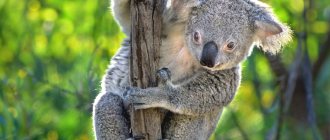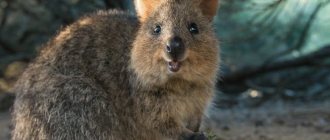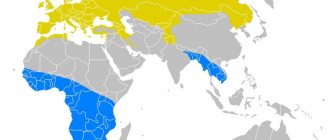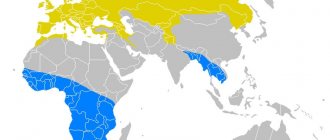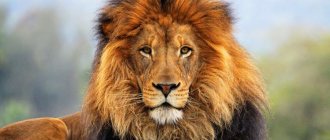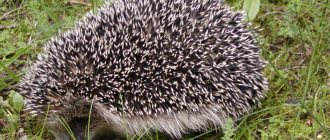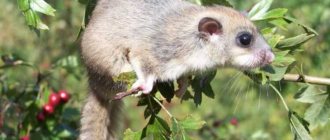- Wild animals
- >>
- Mammals
The pygmy hippopotamus is an animal that was discovered relatively recently (in 1911). The first descriptions of it (based on bones and skull) were made back in the 1850s. The founder of this species is considered to be zoologist Hans Schombur. Additional names for the individual are pygmy hippopotamus and Liberian pygmy hippopotamus (English: Pygmy hippopotamus, lat: Choeropsis liberiensis).
Description
Weight varies between 160-275 kg. The body length is 1.5-1.75 m, and the tail length is 20 cm. The height at the withers is from 0.7 to 1.0 m. These hippos have two pairs of upper and one pair of lower incisors. Dental formula – 2/1, 1/1, 3/3, 3/3; 34 teeth in total. Fangs grow constantly. The skin has a dark brown color, in the abdominal area the shade is noticeably lighter. Large glands produce a red-brown secretion. Its release is observed during intense physical activity, such as running or mating.
The pygmy hippopotamus is often compared to the common hippopotamus. While pygmy hippopotamuses are obviously smaller in size, they have a number of distinctive features from the common hippopotamus. The pygmy hippopotamus has proportional legs, a longer neck, and a smaller head compared to its body size. The toes of pygmy hippopotamuses are more spread out, and the membranes between them are smaller than those of ordinary hippopotamuses. Pygmy hippos have a number of features that are believed to allow them to move more easily on land. Their eye sockets are located on the sides of the head, rather than on the top. The backs are inclined slightly forward, as was previously believed, for easy passage through dense vegetation. A distinctive feature is the separation of the muscular valves of the ears and nose, which close under water.
Natural enemies of pygmy hippos
Photo: Pygmy hippopotamus in nature
In their natural environment, pygmy hippos have several serious enemies:
- crocodiles are the most dangerous predators on the planet. They belong to the group of reptiles. They hunt at any time of the day. They are especially dangerous for those hippopotamus representatives who prefer to lie down near bodies of water. They are capable of catching hippopotamuses as prey, which are many times larger than themselves. It is interesting that crocodiles do not chew the killed carcass (due to the special structure of their teeth, they are not capable of this). Large reptiles tear the dead animal into pieces and swallow pieces of its body whole. Crocodiles choose mainly weak hippos and drown them. Newly born individuals are at greater risk;
- Leopards are the most feared feline mammals. They hunt hippos mostly alone. A leopard is capable of waiting for prey in ambush for a long period. A meeting with such an animal for hippopotamuses almost always ends sadly. In addition to hunting on their own, cats often take away already affected prey from other predators. The danger of a leopard attacking a pygmy hippopotamus increases at night - when the animals go out in search of food;
- Hieroglyphic pythons are very large non-venomous snakes from the class of true pythons. Such individuals hunt mainly at night. They move silently on water and land, which allows them to sneak up on their prey unnoticed. Pythons infect hippos weighing no more than 30 kg. After strangling the victim, the snake begins to gradually consume it. After such a hearty lunch, a python can go without food for several weeks.
Previously, people engaged in uncontrolled fishing were also considered a serious enemy of pygmy hippopotamuses. These animals were prized on the black market and were purchased at high prices. Today, such activities have been practically exterminated. Special control has been established for individuals of this group of hippopotamuses.
Habitat
The pygmy hippopotamus can only be found in low-lying forested areas near a water source. They use swamps, streams, and rivers to shelter from danger and keep their skin moist. The animals avoid open areas, and most movements on land occur in dense vegetation tunnels. Narrow waterways are used by hippos to navigate swampy terrain. Pygmy hippos have been found in river burrows. It is unlikely that they dig burrows themselves, but it is clear that pygmy hippos are capable of increasing the area of existing ones. Since the entrances to the burrows are located on the river side, the animals are mostly submerged underwater and are ideal for a semi-aquatic lifestyle.
Oribi protection
Photo: Oribi from the Red Book
The Oribi Working Group, a multidisciplinary conservation coalition that falls under the Endangered Grassland Species Endangered Wildlife Program, recently and successfully transferred two pairs of endangered oribis to new and much more suitable sanctuaries. Relocating these animals is part of a conservation strategy.
The oribi, a highly specialized antelope native to Africa's temperate grasslands, has been classified as critically endangered in the latest Red List of South African Mammals due to a rapid decline in numbers in recent years. The biggest threat to oribis is the relentless destruction of their habitat and the constant persecution of the species through hunting with dogs.
Landowners using appropriate grassland management and much more stringent monitoring and control of dog hunting can play an important role in improving the situation for oribis. However, this is sometimes beyond the control of landowners, and in these isolated circumstances, Oribi's team works to move endangered animals to safer, more suitable reserves.
So the working group moved the oribis from the Nambiti Game Nature Reserve in KwaZulu-Natal, where recent translocations of cheetahs had put them at risk, to the Gelijkwater Mistbelt Nature Reserve. This sanctuary, with fields of mist, is ideal for housing oribis, which used to live in the area but disappeared several years ago. Guards constantly patrol the area, ensuring that the reserve is a safe haven for displaced oribis.
As croplands are cleared and more livestock graze larger tracts of land, oribi will be pushed into smaller, more fragmented habitats. This pattern is evident in the increasing number of oribis found in protected areas and away from populated areas. Even in these protected areas, the population is not completely protected. For example, Boma National Park and Southern National Park in South Sudan have reported population declines in recent years.
Oribi is a small antelope that is famous for its graceful habit and is found in the savannahs of sub-Saharan Africa. She has slender legs and a long, elegant neck with a short, bushy tail. Today, the oribi is one of the most endangered mammals in South Africa, although they are still quite abundant in many other parts of Africa.
Tags:
- Antelope
- African animals
- Deuterostomes
- Bilaterally symmetrical
- Wild animals of Africa
- Ruminants
- Ruminants
- Animals of Angola
- Animals of Africa
- Animals of Botswana
- Animals of Burundi
- Animals of Zambia
- Animals of Zimbabwe
- Animals of Kenya
- Animals of the Red Book
- Meadow animals
- Animals of Mozambique
- Animals starting with the letter O
- Animals of the fields
- Savannah animals
- Animals of Somalia
- Animals of Sudan
- Animals of Tanzania
- Animals of Uganda
- Animals of South Africa
- Animals of South Sudan
- Animals
- Endangered animals
- Laurasiotherium
- Real antelopes
- Unusual animals
- Artiodactyls
- Placental
- Vertebrates
- Bovids
- Rare animals
- Rare animals of the world
- Herbivores
- Chordates
- Ghostostomes
- Quadrupeds
- Eukaryotes
- Eumetazoans
Habitat range
The range of the pygmy hippopotamus is limited to four countries in West Africa: Liberia, Cote d'Ivoire, Sierra Leone and Guinea. Most of the population, namely 2000-3000 individuals, is concentrated in Liberia. Small populations are concentrated in the other three countries, in their national forests and nature reserves. The range of habitat of the pygmy hippopotamus and its closest relative, the common hippopotamus, does not overlap. Pygmy hippos are not territorial. Males use an area of 165-185 hectares, and females - 40-80 hectares.
Mwe-Mwe family tree history
The world learned about these extraordinary animals relatively recently, but their pedigree raised a number of doubts and discussions. According to some sources, in 1843, the American anthropologist Samuel George Morton arrived in Liberia; at the end of his expedition, one of the aborigines gave him a rather unusual gift - a pair of hippopotamuses, but the scientist was very surprised by the fact that the animals given to him were noticeably different from their own relatives. The difference was in the size of the animal, which was tens of times smaller than the dimensions of an ordinary hippopotamus.
His bewilderment served as the impetus for the study of these mysterious creatures. It was Morton who described them as a new species - Hippopotamus minor, belonging to the Hippopotamidae family. Only after a decade did these unusual creatures arouse the interest of Joseph Leidy, who was an anatomist at the University of Pennsylvania. It was he who described the pygmy hippopotamus under the name Choeropsis liberiensis, which is still used today.
But Europe became acquainted with mwe-mwe (as the locals call it) thanks to the German-born scientist Hans Schomburg. In the summer of 1911, he arrived in Liberia to explore African territories. Then he was lucky to catch five pygmy hippopotamuses in a trap. At his own peril and risk, he transported animals to the zoo in the German city of Hamburg. There they took root quite well and gave birth to offspring; after a while, numerous zoos around the world had these funny representatives of the fauna in their possessions.
This is interesting: The most amazing and rare representatives of the animal world of China
Reproduction
Reproduction of pygmy hippopotamuses has only been observed in captivity. Only monogamous matings were found. This is rare in the wild because the range of one male covers the range of several females. Mating in captivity has been observed on land and in water and occurs one to four times during estrus, which lasts one or two days.
There is very little information about the reproductive behavior of pygmy hippos in the wild. All information is based on observations of animals in captivity. The breeding season is unknown in the wild, but can occur at any time of year in captivity. The interval between pregnancies is 7-9 months. The gestation period can last either 184 days or 210 days. As a rule, one cub is born, but sometimes there can be twins. Cubs weigh 3.4-6.4 kg and are usually well developed. Newborn males weigh slightly more than females. Weaning occurs between 6 and 8 months, and sexual maturity is reached at 3-5 years of age. Births in captivity occur on land and in water. Births that occur deep underwater almost always result in drowning of newborns. The newborns remain in one place while the mother searches for food, then returns to the offspring three times a day to feed. Once the cubs reach three months, they are able to feed on vegetation. This behavior has been observed in captivity and in the wild.
Feeding your "baby"
When it comes to food, this cute eccentric is not at all picky. The only condition is that he strictly prefers a vegetarian diet. You should not try to feed him a piece of meat for the sake of experiment - it will not end well. It will be quite enough for him to create a menu of fresh fruits and vegetables; your pet will also enjoy eating fresh grass or a twig from a tree with great pleasure. Since the caloric content of the pygmy hippopotamus’ favorite food is very low, it will eat most of its active period. To quench his thirst, your four-legged friend most often uses water from where he carries out his daily ablutions, but if the water in his pond is not very clean, it is recommended to install a container with drinking water in the enclosure. It would be nice to have grassy meadows on the territory of your summer cottage, then your pet can easily use them as pasture, which will partially simplify your responsibilities for caring for him.
Security status. This animal is currently classified as “endangered”. There are a number of reasons and factors due to which the population of pygmy hippos is significantly decreasing every day. These include massive deforestation, the use of their native territories for housing or agricultural work. Also, one of the most serious reasons is wars and civil conflicts on the African continent. Poachers and hunters play a significant role, as well as hungry predators eager to eat hippopotamus meat. In the states that are revered as the homeland of these dwarf animals, a number of programs are being developed to protect these wonderful animals.
Behavior
Unlike their relatives, common hippos, pygmy hippos are solitary animals. They were seen in pairs only during mating or raising young. Individuals tend to avoid each other due to fecal markings released through active tail wagging during defecation. If a collision between two pygmy hippos is inevitable, they simply ignore each other.
Pygmy hippos prefer a nocturnal lifestyle. About six hours a day are devoted to feeding. During the day they hide in the water or rest on the shore. They sleep on the ground, sometimes in burrows or caves. The place to sleep changes once or twice a week.
Life image of hippopotamuses
Hippos never live alone. This is explained by their long-term habits from the moment of their appearance. One crowd of hippopotamuses can number from 20 to 100 animals. Group housing is explained by safety; few predators are capable of harming a group of such large animals. As has already been said, the main activity in the life of a hippopotamus begins with the arrival of evening. Only then do hippos begin to look for food for themselves and their offspring.
The price of males in a herd of hippopotamuses is to ensure the protection and safety of females and cubs. Females, however, provide calm and measured sleep during the daytime on the shore or in shallow water; they control their cubs, allowing them to enjoy their rest in every way.
It is important to note that male hippos are characterized by aggressive behavior. Another time the male reaches seven years of age, he becomes a full member of the group
This event gives rise to his struggle for territory and relationship in the herd. There are various methods for this in the animal kingdom. This includes roaring, wide opening of the mouth, and spraying other individuals with manure and urine.
In this way they want to show their strength and power, but it is sometimes very difficult for young males to strengthen their position in the herd. Then their rivals become adult hippos, which are ready to enter into battle with their relatives for a place under the sun. The last resort may be to kill a young opponent.
Males are extremely scrupulous in monitoring the territory that belongs to them. They seize possession through markings. Males consider both places for rest and places for food to be their territory. Even if male hippos see other contenders, they still mark home possessions. To conquer and capture new places, hippos can even leave the water during the off-season.
Hippos communicate with each other using sounds. Hippos always warn each other about danger. They can also propagate sound waves in water. Their roar can be compared to the roar of thunder during the chronos of a thunderstorm. In the entire animal kingdom, only hippos can move bread and salt with each other under water. Their sound is audible to their relatives, both on land and for some unknown reason in the water. Hippopotamuses are capable of transmitting sound information to each other even when its nostrils rise above the water in any month.
At the moment when the body of a hippopotamus is immersed in water, the head of this animal can serve as an island for birds, from where they can catch fish and get their own bread. Hippos react to birds calmly. This is explained by the existence of a certain tandem among them. This union is justified by what is the matter? the birds help the hippopotamus get rid of the parasites that live on top of its entire body. Even near the eyes of a hippopotamus, unpleasant worms can live, which can cause a lot of inconvenience. Feathers feed on these parasites, making life easier for hippos.
Such an alliance with birds can be considered an exception, because hippos are not at all calm and peaceful animals. They are dangerous in their habitat. With their powerful jaws, hippos are capable of killing at least a crocodile in an instant.
The behavior of hippopotamuses is often unpredictable, especially caste unpredictability is characteristic of males and females who protect their cubs. If another animal angers the hippopotamus, it is ready to kill it. This can happen under different circumstances. A hippopotamus can gnaw the throat of its victim, trample it, kill it with its fangs, or simply drag it away with it to the depths.
Communication and perception
Pygmy hippos use fecal markings to alert other hippos to their presence. Like other mammals, they use olfactory cues that communicate reproductive status. Pygmy hippos are generally silent animals, but sometimes snort, grunt, hiss and squeak. Little information is known about other signals.
Hippopotamus diet
Even despite their impressive size and power, as well as their terrifying appearance and noticeable aggressiveness, all hippos belong to the category of herbivores. With the onset of evening, gregarious representatives of the order Artiodactyla and the family Hippopotamus move to a pasture with a sufficient number of herbaceous plants. If there is a lack of grass in the selected area, animals are able to move several kilometers away in search of food.
To provide themselves with food, hippos chew food for several hours, using for this purpose forty kilograms of plant food per feeding. Hippos feed on all kinds of herbs, reeds and young shoots of trees or shrubs. It is extremely rare for such mammals to eat carrion near water bodies. According to some scientists, eating carrion is facilitated by health problems or a deficiency of basic nutrition, since the digestive system of representatives of the order Artiodactyls is completely unsuitable for fully processing meat.
The same paths are used to visit the pasture, and the animals leave the grassy feeding areas before dawn. If they need to cool down or gain strength, hippos often wander even into other people's waters. An interesting fact is that hippos are not able to chew vegetation like other ruminants, so they tear the greenery with their teeth, or suck it in with their fleshy and muscular, almost half-meter lips.
Nutrition
Pygmy hippos are vegetarians or herbivores. They feed on a wide variety of plant matter, including grass, broadleaf plants, grasses, semi-aquatic plants, herbaceous shoots, forbs, sedges, ferns and fallen fruits. Pygmy hippos have a four-chambered stomach and are considered pseudo-ruminants.
